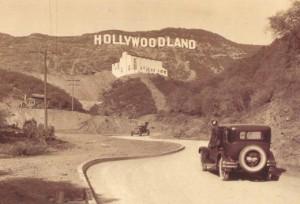 Peepshow Pioneers (1889-1907)
Peepshow Pioneers (1889-1907)
The origins of the movies are discussed which include picture flip books, projection shows, and the famous bet where photographer Eadweard Muybridge proved with a series of cameras that a horse does indeed have all four feet in the air at one time when he runs. We also see how Thomas Edison tinkered with the idea of the movies and made it in to an industry. We learn of the brilliance of early filmmakers like Georges Méliès, Edwin S. Porter, and D.W. Griffith and the rise of early stars such as Mary Pickford and Lillian Gish. We also hear the stories of Mayer, the Warners, Laemmele, Goldwyn, Zanuck, and Fox, mostly Jewish immigrants who started the studio system and eventually moved the industry west to Hollywood.
The Birth of Hollywood (1907-1920)
As the movie industry continues to explode and moguls set up shop in Los Angeles, we see the incredible success and controversy surrounding D.W. Griffith's "The Birth of a Nation", the rise of cowboy stars such as William S. Hart, Brono Billy and Tom Mix, and the great success of Max Sennett, his Keystone Studio, and his discovery of the young, impoverished, and ambitious Charles Chaplin. We also see the rise of stars like Mary Pickford and Douglas Fairbanks, producers such as Thomas Ince and Adolph Zucker, and the important roles women played not only in front of the camera but behind it as well. As the country marched into World War I, the movie industry was there to support and film it and by the end of the decade, the United States had asserted itself as the top filmmaking nation in the world.
The Dream Merchants (1920-1928)
As the movie industry has asserted itself in America, it now begins to deal with power struggles, scandals, and calls for censorship. Charlie Chaplin, Mary Pickford, Douglas Fairbanks and D.W. Griffith form United Artists, Joe Kennedy develops RKO, and titan studio MGM comes into formation. Stars such as Rudolph Valentino, Lon Chaney, Buster Keaton, Harold Lloyd, Gloria Swanson, Greta Garbo, and Clara Bow come into focus and moviemakers Hal Roach, Erich von Stroheim, and Cecil B. DeMille strive to bring their visions to the screen. The Academy is formed to thwart unionizing and the first Award ceremony is held in 1927 as the talkies begin to be ushered in and the industry becomes revolutionized forever.
Brother, Can You Spare a Dream (1929-1941)
The Stock Market Crash, The Great Depression, and the audience demand for talking pictures revolutionizes the film industry in the 1930s as old stars like Mary Pickford, Clara Bow, and the silent clowns fade out and a new line of stars such as Clark Gable, Bette Davis, The Marx Brothers, Judy Garland, and Shirley Temple take their place. Hollywood makes makes movie stars out of radio personalities like Bing Crosby, Busby Berkeley and Fred Astaire become kings of the musical, and atypical stars like James Cagney and Edward G. Robinson begin to rise. A demand for writers is created and Herman J. Mankiewicz and Ben Hecht heed the call and power players such as The Selznicks, The Cohns, and Howard Hughes have their day. Walt Disney promotes feature length animation, "The Wizard of Oz" and "Gone with the Wind take audiences by storm, and the moguls have differing responses to the growing threat across the Atlantic.
Warriors and Peacemakers (1941-1950)
While Europe is at war, much of Hollywood is fearful of speaking out in fear of losing the foreign market aside from Charlie Chaplin who releases "The Great Dictator". When America finally enters the war, the film industry goes into full swing as they campaign for the troops, make propaganda films, and sell war bonds. Male stars like James Stewart and Clark Gable enlist, directors like John Ford and John Huston make war documentaries, Bob Hope and Betty Grable entertain the troops, and female stars like Bette Davis and Barbara Stanwyck greet soldiers on their way over at The Hollywood Canteen. Daryl Zanuck releases Ford's social conscious "The Grapes of Wrath" and Preston Sturges makes funny films laughing at war. John Wayne, Humphrey Bogart, Joan Crawford, Gregory Peck and Cary Grant are the preeminent film stars, Orson Welles makes "Citizen Kane", and "Casablanca" becomes an unanticipated success. After the war, new tastes develop and film noir as well as social conscious films emerge. A lawsuit by Olivia de Havilland and the work of agents like Charles Feldman and Lew Wasserman lead to more rights for stars and labor strife leads to the HUAC hearings and the Hollywood Blacklist. By the end of the 40s, The Paramount Decree will strip the moguls of their theaters and the television will become a viable threat to the industry.
The Attack of the Small Screens (1950-1960)
As television and the mobility of the 1950s draws audiences away from the movies, Hollywood embarks on a bigger is better campaign with the promotion of drive-ins, 3D, cinerama, technicolor, cinemascope, and stereophonic sound. TV stars like Lucille Ball, Sid Caesar, and Jackie Gleason reach extreme heights of popularity and Hollywood begins to lure television stars and writers and eventually enter the medium by leasing films, producing TV movies, as well as TV shows, particularly with Walt Disney. Star Power begins to combine with emotional intensity as we see stars like James Dean, Marlon Brando, Liz Taylor, Montgomery Clift, Sidney Poitier, and Burt Lancaster while Marilyn Monroe sizzles up the screen. Alfred Hitchcock and Billy Wilder make their marks as directors and Cold War fears lead Charlie Chaplin to become outspoken and exiled. United Artists and the agents at MCA begins to rise and RKO dies largely due to the eccentricities of owner Howard Hughes. We see the deaths of Louis B. Mayer, William Fox, Jesse Laskey, Harry Cohan, and Harry Warner, the resignation of Daryk Zanuck, and the overall decline of the studio system which was being supplemented by independent filmmakers such as Roger Corman.
Fade Out, Fade In (1960-1969)
As the 1960s begin with a mogul's son taking the Oath of Office and the Hollywood blacklist is dissolved, the films of the decade see a great change being influenced by the postwar film revolution in Europe and specifically the films from Italian Neorealism, the French New Wave, and specifically the films of Bergman, Kurosawa, Truffaut, Godard, Antonioni, and Fellini. Kubrick made "Dr. Strangelove" spoofing the cold war madness as well as "2001" and"Bonnie and Clyde" revolutionized American pictures. "Cleopatra" bankrupts Fox, Psycho is a hit, and Marilyn Monroe dies. Mike Nichols makes "Who's Afraid of Virginia Woolf?" and "The Graduate" and counterculture movies such as "Easy Rider" and "Midnight Cowboy" change the game as well. International films blow up such as "Lawrence of Arabia" and the Bond films, and the studios begin to develop sequels. As the decade closes and the studios become conglomerates and titans like Walt Disney and David O. Selznik die, a new generation of filmmakers await in the wings and in the crowds to take the reins and perpetuate are faith in the movies.

